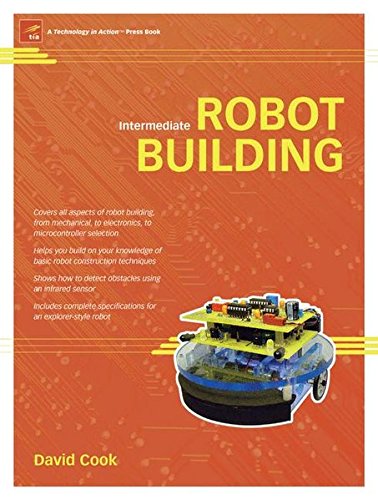This review was originally written for the robots.net blog

David Cook is webmaster of the popular robotroom.com website, a collector of bizarre safety signs, and author of Robot Building for Beginners. His new book, titled Intermediate Robot Building, explores more advanced issues than his previous book. This one is aimed at the reader ready to move from building robot kits to designing and building a robot from scratch. If you’ve been wondering how to control a motor, build an H-Bridge, or how to attach wheels to your motors in a precise and reliable way, this book is for you. Read on for a more detailed review.
Intermediate Robot Building assumes you understand the basics and have built at least one robot from a kit. The book delves into some of the common problems that face robot builders working on more complex robots built entirely from scratch.
The book focuses primarily on hardware issues such as machining metal parts, connecting wheels to motors, controlling motors, and building robot power supplies, briefly covering microcontrollers and sensors as well. This book provides far more detail on the hardware aspects of robot building than any other I have seen to date and is worth picking up if you want to learn more about hardware.
If you’ve browsed the table of contents above, you may wonder why four chapters of the book are spent on connecting wheels to motors. To quote David, “Until people actually try to build a robot themselves, they don’t realize that one of the more difficult tasks is finding a precise and reliable way to connect a motor to a wheel”. Speaking as someone who is primarily a software hacker, I can certainly vouch for the difficulty of solving seemingly simple hardware problems like mounting wheels, especially without proper tools or experience. The book offers several solutions and describes each in a detailed, step-by-step way with plenty of diagrams and photos.
I particularly liked this book’s promotion of standard SI (metric) units, which are used everywhere else in the world, instead of the medieval system still favored in the US. So you won’t have to measure your robot’s speed in furlongs per fortnight while using this book!
The book also promotes the use of modular robotics. By creating drive modules, motor control modules, power modules, logic control modules, you can assemble your robot from the modules rather than having to build the entire robot as a single project. The modules you build can be improved or re-used to create other robots. The modules described in the book are used to create a robot, called Roundabout, that avoids walls and obstacles using IR sensors.
One convention adopted in the book may seem a bit strange at first. All the schematics in the book use a mix of normal schematic symbols for some components (e.g. capacitors, zener-diodes, transistors) but represent other components iconically (e.g. resistors, photo-diodes). This can be a bit confusing initially. The author explains his reasons early on for this and another exception to modern schematic technique, the old-style use of a “jog” to represent crossed wires that do not connect. David’s experience is that beginners find these wiring diagrams easier to understand, hobby robot builders often prefer them to formal schematics, and he believes his diagrams reduce the chance of mistakes. It’s really a minor issue and experienced builders used to contemporary schematics should be able to adapt easily enough.
Overall, the book provides lots of practical information to help the reader over the difficult areas of building a homebrew robot. Recommended!
